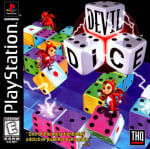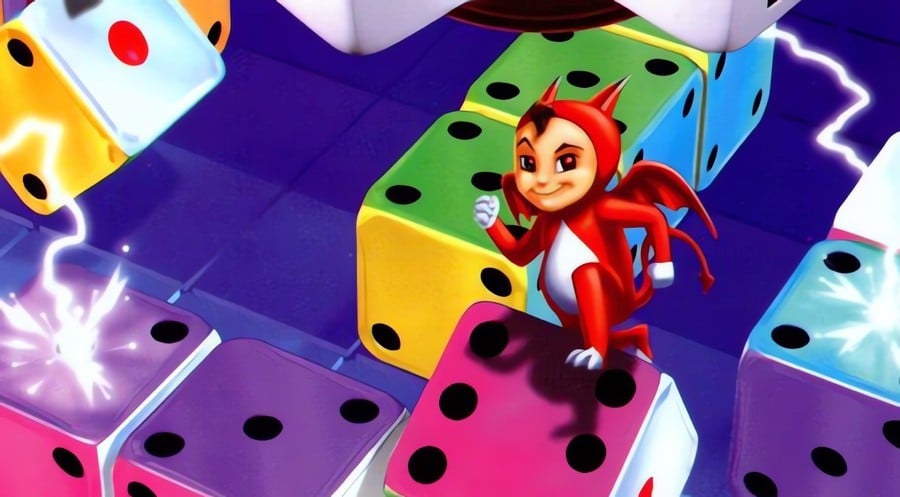
You likely already know about Sony's Net Yaroze project. It was a well-publicised global endeavour which attempted to allow PlayStation 1 enthusiasts the opportunity to create games for the system. Buying in to the project provided users with a black Net Yaroze dev kit, plus various tools and documents, and access to private forums. Several universities in the UK also built games design and programming courses around the Net Yaroze, giving it a solid foothold in academia.
Anyone able to produce a polished enough game might have seen it distributed on the Official UK PlayStation Magazine demo disc. The final issue, 108, filled the disc with a compilation of the best Net Yaroze games (keep in mind Net Yaroze distribution was more limited in the US, seemingly only via PlayStation Underground; exposure to Yaroze games was stronger in Europe).

Ryan Butt, who was editor of Official UK PlayStation Magazine, including the final issue, recalls: "I first heard about the Yaroze when I was the editor of Play magazine and was very intrigued by the prospect of a return to bedroom coding, although the cost of the machine was high. To my knowledge, no Yaroze game was ever actually released to buy, but I'm sure it helped keep a few people off the streets. Yaroze games were small in size and acted as good space fillers to compliment whatever official demos were included on the disc. We had a full database of Yaroze titles and provided Sony with a list each month of what we wanted. The reasoning behind the inclusion of so many Yaroze games was, well, Sony has them; if we don't put them out there, they'll never get seen or played. Almost like, 'This is your mag, so here are the games you've made.' We knew exactly when the last issue would be and so could plan things, hence issue 108's cover being Lara Croft's arse heading off over the horizon – she being the biggest success story of the PS1's life."
Ryan raises a captivating topic in his statement. Not Lara's arse, but the fact that, to his knowledge, no Net Yaroze title was commercialised. It's interesting because the common belief is that Devil Dice for PS1 started on Net Yaroze. Known in Japan as XI [Sái], it was developed by Shift and released in 1998. It saw releases in all major territories and received several sequels, later rebranding as Bombastic outside of Japan.
To explain the mechanics simply: it tasked players with standing atop a field of dice and walking (or pushing) them into position to disappear. Part of a new wave of puzzle games which moved away from the block-falling template set by Tetris, it was wildly original, fiendishly addictive, and quite challenging. It's a pity the series has been dormant for so many years, because it still feels fresh and inventive today. This entry on Eastern Mind also gives an explanation for the unusual name: "XI, read sái, is a letter from the Greek alphabet. Its use in this context derives from the Japanese word Saikoro (骰子 in its Kanji form) meaning dice." If you follow this link, Eastern Mind also has some adorable XI comics with English translations.
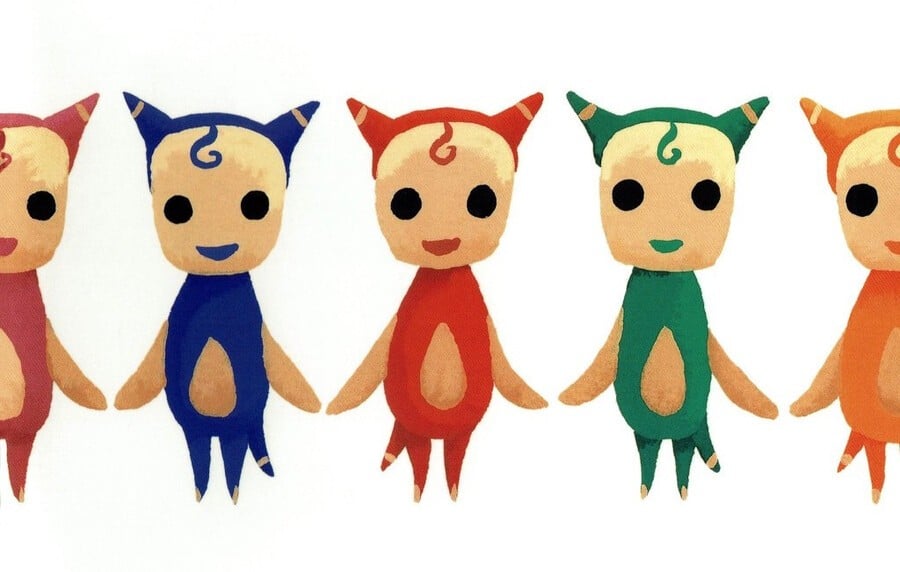
As stated, it's a common belief that Devil Dice started as a Net Yaroze title. To highlight how common this is, search Google for the name Devil Dice with "Net Yaroze" in speech marks, to guarantee it only returns results mistaking it for a Net Yaroze game. Our search attempt returned over 16,000 results. Yours might vary, but it shows how widespread the misinformation is.
Several Twitter results also pop up – in fact, searching Twitter itself brings up hundreds and hundreds of people, all absolutely convinced of Devil Dice's origins. There's also this incredible Reddit thread – the original poster is trying to find the original Net Yaroze version, with little success, while other posters reply, convinced they saw it somewhere. They couldn't find it either, but they're all searching while talking nonsense about its existence. Every statement claiming Devil Dice or XI has any connection to Net Yaroze is untrue.
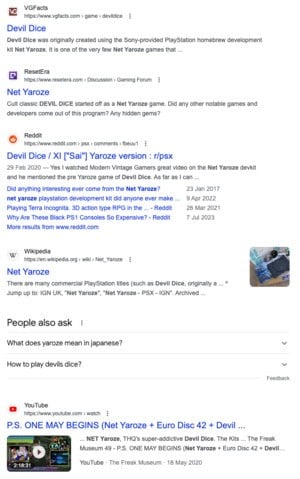
Given how most sources online claim Devil Dice started as a Net Yaroze project, we contacted its developer Shift in the hopes of interviewing Shuichi Yano, who was the manager and programmer on the first game. We're unsure why in the last 25 years or so no one thought simply to email the company. It was pretty easy.
General affairs manager Shota Tsuboi was our liaison and, as was discovered, Devil Dice has absolutely nothing to do with Net Yaroze. It was created through another project of Sony's called "Game Yaroze". Some places Romanise it as "yarouze", which is technically correct since this is what the hiragana (やろうぜ) says – but since that's also the exact same hiragana used for Net Yaroze, we're standardising the English spelling. (Yes, we are aware that Sony's now dead website URL spelled it 'gameyarouze' – we're standardising it anyway.) The literal translation of yaroze is "let's do it".
Our initial line of enquiry was under the mistaken beliefs highlighted above, and so our questions were written from that angle. We assumed we'd be chatting with Yano about the Net Yaroze and hobbyist programming. Tsuboi replied, correcting our mistake: "Thank you for your message. Yes, Shuichi Yano is part of Shift Inc. Shuichi Yano is a member of the team who made XI [sái], also known as Devil Dice, on PlayStation. However, he was not a Net Yaroze developer, rather he was a successful applicant of 'Game Yaroze'. As far as Yano knows, there was no connection between Game Yaroze and Net Yaroze. Are you sure that you want to interview Shuichi Yano? If there's no doubt, then he is ready to be interviewed."
This is quite the bombshell revelation!
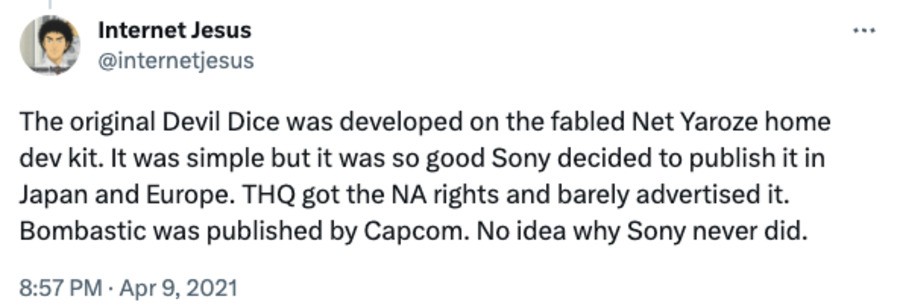
We'd also gone to great lengths to convey how much love the series has around the world, especially in Europe, to which Tsuboi added: "Yano didn't know anything about XI's popularity in Europe. He is really interested about this, and would be very happy if he could read some detailed documents or web pages about fans outside of Japan. It would be helpful for him if you could suggest such information. He wants to talk about XI after hearing your additional comments."
There are a lot of non-Japanese enthusiasts online, so sending further reading material was easy. But we put plans for interviewing Shuichi Yano on the back burner – of more pressing concern is trying to correct historical misinformation. Over 16,000 examples of it! At this point the falsehood has been repeated so often, for so long, we might never be able to undo the damage.
The root cause would appear to be a simple misunderstanding conflating Game Yaroze with Net Yaroze, by virtue of them both containing the word yaroze. If you've never heard of Game Yaroze, don't feel surprised. The world of Net Yaroze is extremely well documented in English, whereas Game Yaroze never really was, since it was exclusive to Japanese residents – in fact, you have to put it in speech marks, and even then search engines still conflate it with Net Yaroze!
One of the few journalists to accurately delineate the two, and correctly attribute Devil Dice's origin, was Brandon Sheffield in this 2005 news report. To quote Sheffield: "Sony Computer Entertainment Japan has announced its Game Yaroze (Let's Make a Game) 2006 competition. This competition, now in its 11th year, asks aspiring game designers to send in their ideas, and for those accepted, Sony will finance the project with the loan of an office and staff, and will pay living and production expenses. Previous successful games created through this process include XI [sai] (AKA Devil Dice) and the Doko Demo Issho series. Application is to be done through Sony Japan's dedicated website. The contest is only open to Japanese residents. Upon completion of the software, Sony reserves the right to put it on the market, which, for the armchair game designer, is perhaps the greatest prize of all."
Part of the problem is that Sony's website, documenting the various Game Yaroze creations, and featuring interviews with successful applicants, has been scrubbed from the internet. It's now only available through the Wayback Machine.
As you can imagine, this makes it tricky to get a complete and accurate picture. But looking at a 2007 capture of the site, it seems the auditions started in 1995 and would run periodically. XI and Doko Demo Issho feature prominently at the top of the homepage, clearly showing how proud Sony was of their creation, alongside a grid of 30 game covers. Several of these include the aforementioned series, but we can also see Chain Dive and SkyGunner displayed. We mention these two specifically, given we could find no other literature online connecting them to Game Yaroze. This grid of blurry images is almost like a faded Rosetta Stone, revealing unspoken information which warrants further investigation.
Some of the archived text on Sony's official site explains:
'Game Yaroze!' aims to create new software by providing a PlayStation production environment and supporting creators with new talents. The audition was held from 1995 to 1999. Among them, many excellent creators with new ideas were discovered, and many innovative works such as XI [sái] and Doko Demo Issho were created. Starting with 'Game Yarouze! Summer' in 1995, the auditions were held a total of six times until 1999, and about 3,000 people, from students to working adults, submitted 1,200 entries. About 200 creators passed the test, and so far more than 30 titles have been released. Even now, 10 years after the start, creators from Game Yaroze!, such as Shift which produced XI [sái], and BeXide which produced Doko Demo Issho, are still making games.
The now-dead website also featured an interview with the planner on XI, Yuichi Sugiyama. Thankfully, it, too can be accessed through the Wayback Machine. He describes seeing Game Yaroze advertised online and bringing together university friends to enter, then he describes the audition process to be selected by Sony, and the fact that XI was actually the second proposal he made. It's a short but nice interview.
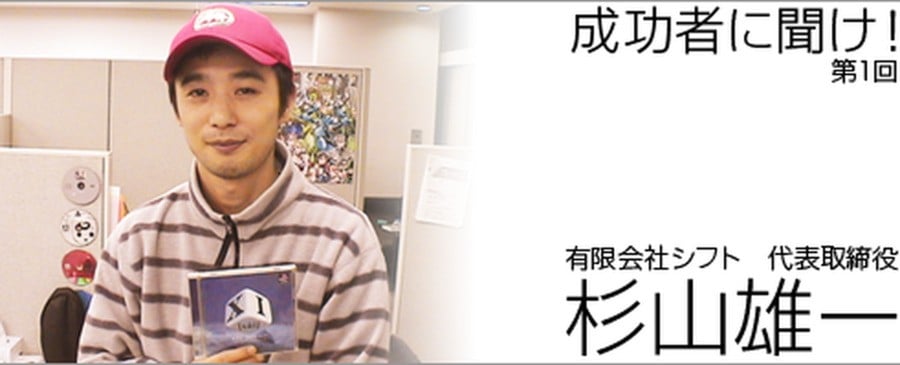
So there you have it, readers. Net Yaroze was an international endeavour where Sony provided hobbyists a dev kit for use at home. Game Yaroze was a competition, exclusive to Japan, where Sony would provide a dev environment for your game's creation and possibly commercialise it. Devil Dice, or XI, came about through the latter of these two. Despite the attempts of a few journalistic outlets, the majority of non-Japanese speakers ended up conflating the two.
The absolute conviction that many people have makes us think about the idea of False Memory. It's actually somewhat understandable, given that Devil Dice appeared on demo discs alongside actual Net Yaroze titles. The widespread nature of this belief also makes it an example of the Mandela Effect. A phenomenon where a large group of people share the same memory of something which does not reflect actual reality. There's been several famous examples over the years, and it can happen to any of us. Have you experienced it? If so, post in the comments.
This article was written using interview materials from The Untold History of Game Developers Volume 5. John Szczepaniak is an internationally published author who has definite memories of writing this book, and you can't prove otherwise.

